Analysis of HRM Issues and Solutions at Govia Thameslink Railway
VerifiedAdded on 2020/04/21
|12
|3672
|98
Report
AI Summary
This report analyzes the human resource management challenges faced by Govia Thameslink Railway (GTR). The introduction highlights the importance of effective HRM in achieving organizational goals and identifies employee dissatisfaction, strikes, and passenger disruptions as key issues. The report delves into organizational problems, including conflicts over pay rates, extra responsibilities for employees, and the need for a viable HR planning process. Solutions such as negotiation, collective bargaining, clear communication, and defined job roles are proposed. Furthermore, the report emphasizes the importance of a structured HR planning process, outlining steps such as analyzing objectives, assessing manpower inventory, forecasting HR demand and supply, analyzing gaps, formulating action plans, and providing training and development. The report recommends developmental activities, particularly focusing on a transparent and effective recognition and rewards framework. The influence of employment legislation and the potential impact of Brexit on HR practices are also discussed, providing a comprehensive overview of HRM issues and solutions for GTR.
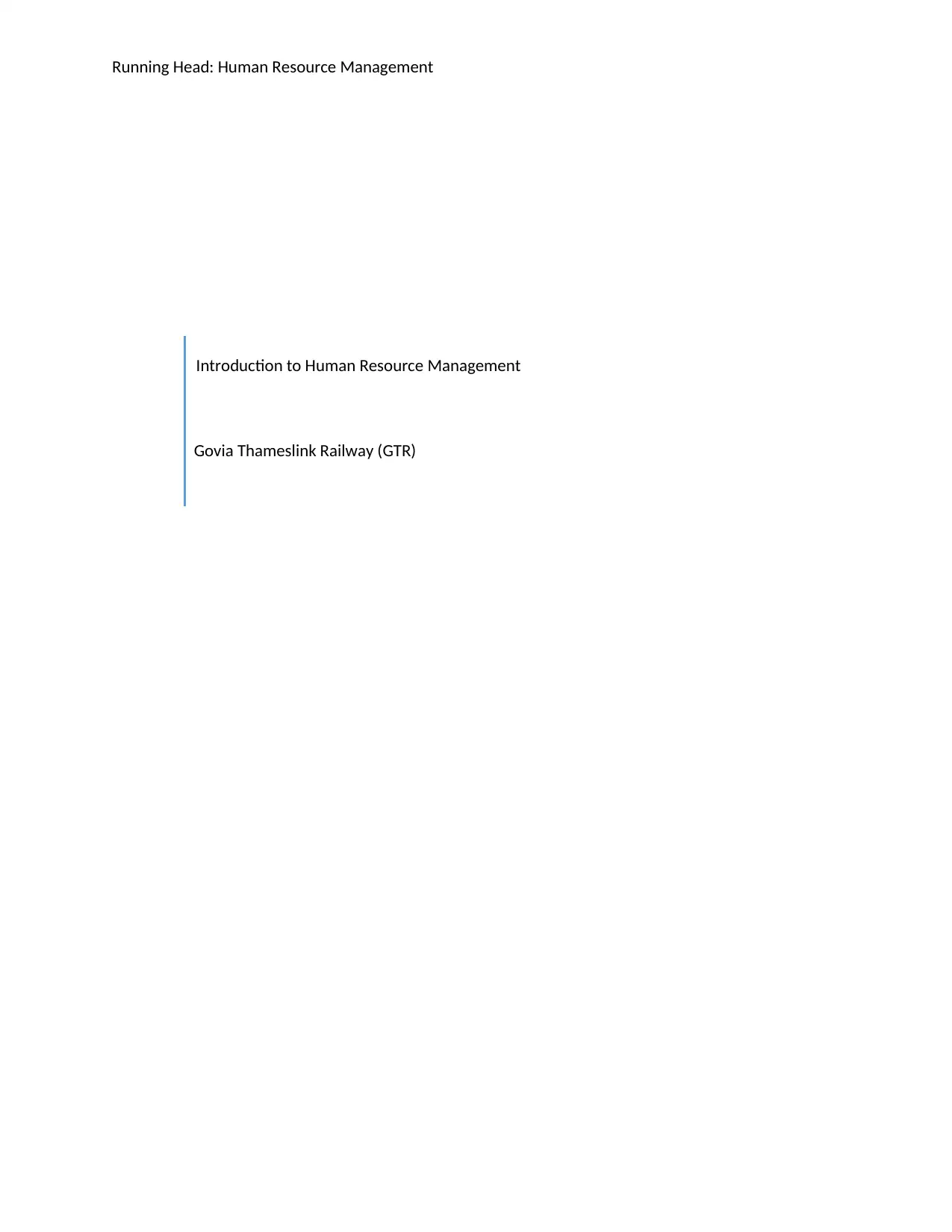
Running Head: Human Resource Management
Introduction to Human Resource Management
Govia Thameslink Railway (GTR)
Introduction to Human Resource Management
Govia Thameslink Railway (GTR)
Paraphrase This Document
Need a fresh take? Get an instant paraphrase of this document with our AI Paraphraser
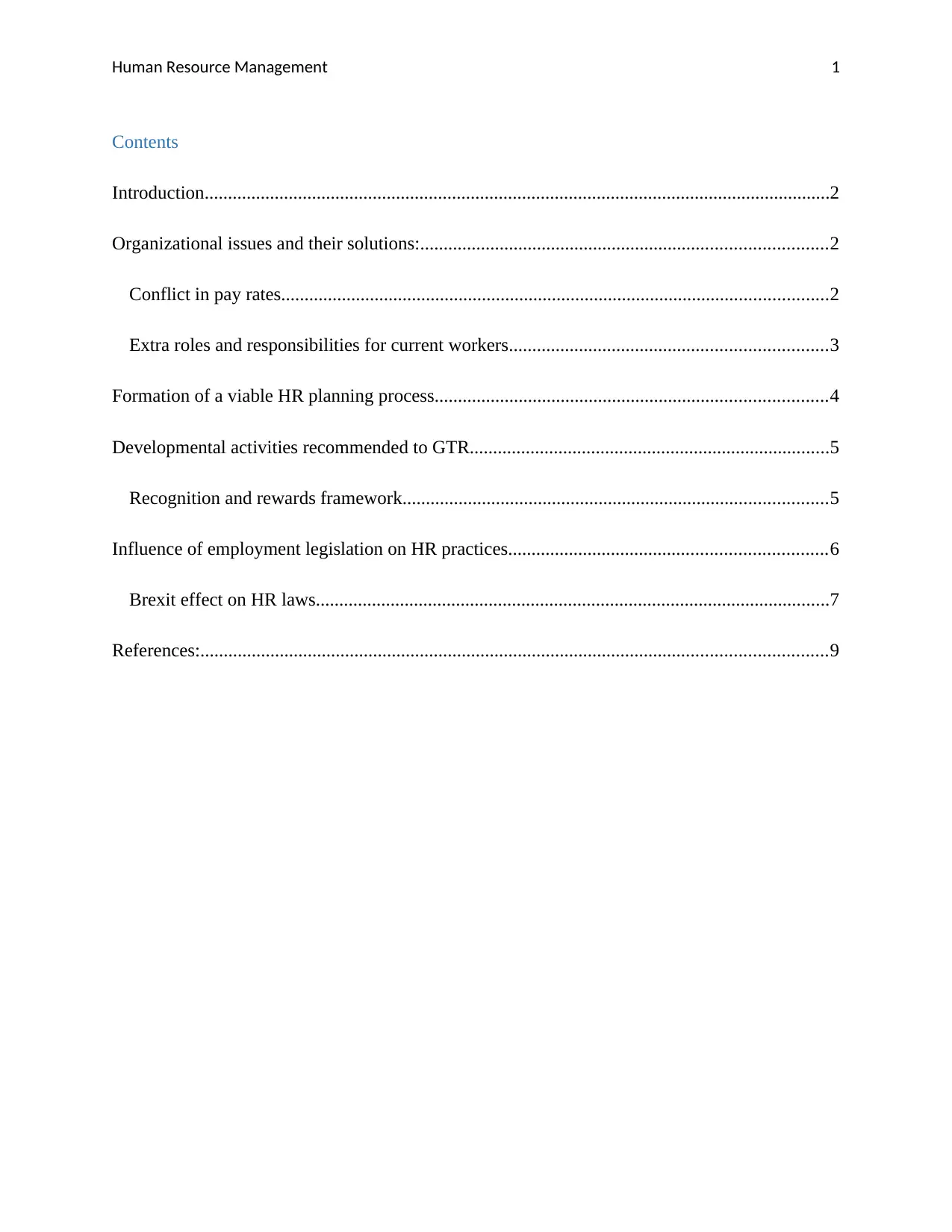
Human Resource Management 1
Contents
Introduction......................................................................................................................................2
Organizational issues and their solutions:.......................................................................................2
Conflict in pay rates.....................................................................................................................2
Extra roles and responsibilities for current workers....................................................................3
Formation of a viable HR planning process....................................................................................4
Developmental activities recommended to GTR.............................................................................5
Recognition and rewards framework...........................................................................................5
Influence of employment legislation on HR practices....................................................................6
Brexit effect on HR laws..............................................................................................................7
References:......................................................................................................................................9
Contents
Introduction......................................................................................................................................2
Organizational issues and their solutions:.......................................................................................2
Conflict in pay rates.....................................................................................................................2
Extra roles and responsibilities for current workers....................................................................3
Formation of a viable HR planning process....................................................................................4
Developmental activities recommended to GTR.............................................................................5
Recognition and rewards framework...........................................................................................5
Influence of employment legislation on HR practices....................................................................6
Brexit effect on HR laws..............................................................................................................7
References:......................................................................................................................................9

Human Resource Management 2
Introduction
Management of human resource is a crucial part of every organization. It is the base of any firm
that safeguards that the employees are hired efficiently, trained effectively, rewarded fairly and
treated appropriately (Hendry, 2012). The efficacy of human resources plays a vital role for the
successful accomplishment of organizational goals. This case lays emphasis on numerous issues
that are faced by GTR owing to dissatisfaction of employees. The employees of the firm have
deliberately been organizing strikes to receive a higher pay, apt hours of work and professional
working culture. Such strikes are unfavorably affecting numerous passengers who shuttle on a
daily basis. In this particular report, we have attempted to identify and source crucial human
resource management disputes occurring at GTR and have aimed to recommend elucidations for
each of them.
Organizational issues and their solutions:
As given in the case, GTR is presently facing various issues that have led to unsatisfied
employees and retaliation from their end. Also, because of the criticality of railway industry
along with large number of travelers, employee strikes are adversely impacting various regular
passengers. The demands that are presented by the unions of employees are unreasonable and
irrational. For the effective functioning and profitability of the firm, GTR cannot succumb to
those demands and hence they are unable to reach a grey ground. The predominant
organizational issues faced by GTR are as follows:
Conflict in pay rates
It has been noticed in the case study that there exists a serious skirmish between the wages that
are currently paid to employees and the expectations that they have for the same. Salaries that the
employees take home are undoubtedly the most significant part of every organization (Anker,
2017). Salaries lead to motivation among employees and give them a reason to work efficiently.
The case observes that employees are frequently conducting strikes and asking for irrational
hikes which is unfeasible for the firm to deliver. Such strikes have adversely been impacting over
300000 travelers who commute using GTR railways. Hence it is imperative that urgent and strict
measures are undertaken to address these issues.
Introduction
Management of human resource is a crucial part of every organization. It is the base of any firm
that safeguards that the employees are hired efficiently, trained effectively, rewarded fairly and
treated appropriately (Hendry, 2012). The efficacy of human resources plays a vital role for the
successful accomplishment of organizational goals. This case lays emphasis on numerous issues
that are faced by GTR owing to dissatisfaction of employees. The employees of the firm have
deliberately been organizing strikes to receive a higher pay, apt hours of work and professional
working culture. Such strikes are unfavorably affecting numerous passengers who shuttle on a
daily basis. In this particular report, we have attempted to identify and source crucial human
resource management disputes occurring at GTR and have aimed to recommend elucidations for
each of them.
Organizational issues and their solutions:
As given in the case, GTR is presently facing various issues that have led to unsatisfied
employees and retaliation from their end. Also, because of the criticality of railway industry
along with large number of travelers, employee strikes are adversely impacting various regular
passengers. The demands that are presented by the unions of employees are unreasonable and
irrational. For the effective functioning and profitability of the firm, GTR cannot succumb to
those demands and hence they are unable to reach a grey ground. The predominant
organizational issues faced by GTR are as follows:
Conflict in pay rates
It has been noticed in the case study that there exists a serious skirmish between the wages that
are currently paid to employees and the expectations that they have for the same. Salaries that the
employees take home are undoubtedly the most significant part of every organization (Anker,
2017). Salaries lead to motivation among employees and give them a reason to work efficiently.
The case observes that employees are frequently conducting strikes and asking for irrational
hikes which is unfeasible for the firm to deliver. Such strikes have adversely been impacting over
300000 travelers who commute using GTR railways. Hence it is imperative that urgent and strict
measures are undertaken to address these issues.
⊘ This is a preview!⊘
Do you want full access?
Subscribe today to unlock all pages.

Trusted by 1+ million students worldwide

Human Resource Management 3
1. Negotiation with the unions: The top management at GTR including the directors must
conduct one on one meetings with the unions ASLEF and RMT. These negotiations
should be conducted effectively among leaders of both parties and genuine efforts must
be put in order to reach a feasible conclusion (Korobkin, 2014). Some details of
negotiating should be ensured by GTR as well as the unions.
a. Both leaders must be well prepared and must have a valid and clear justification of
each of the demands.
b. Timing of the meeting is also extremely important in ensuring a fruitful negotiation.
Anything which is demanded at the right time can lead to positive results (Chen, 2015).
c. Both leaders must anticipate a compromise and aim to bridge the gap that exists
between both demands rather than being adamant and sticking to their own grounds
(Saeed, 2014).
d. Conclusions drawn must be detailed and not vague. For example, instead of promising
an increase in salary, the exact percentage of hike and also the time duration for the same
should be decided.
e. Once all the negotiations are done, both the parties must remain committed to what has
been decided under all circumstances (Robins, 2014). Both the unions must make sure
that they should not conduct any strike again and the firm GTR must make sure that their
employees are paid exactly as per what is promised.
f. Closing the meeting well also plays a critical role. It should be done with a recap and
confirmation of the final decided pay of employees.
2. Collective Bargaining: Collective bargaining is the process including negotiation of
salaries, wages, working conditions and other benefits between employers and a group of
employees (Cooper, 2015). These interests are most commonly presented to the firm by
labor unions, which in the current case are, ASLEF and RMT. The right of collective
bargaining is given to all the employees (Cheng, 2017). The process of collectively
bargaining includes the following steps:
a. Preparation: collective bargaining effort requires sufficient preparations by both
employees and employers.
b. Discussion: After the preparation, both parties must discuss in detail upon the issue at
hand. GTR as well as RMT and ASLEF will be highlighting their points and discussing
1. Negotiation with the unions: The top management at GTR including the directors must
conduct one on one meetings with the unions ASLEF and RMT. These negotiations
should be conducted effectively among leaders of both parties and genuine efforts must
be put in order to reach a feasible conclusion (Korobkin, 2014). Some details of
negotiating should be ensured by GTR as well as the unions.
a. Both leaders must be well prepared and must have a valid and clear justification of
each of the demands.
b. Timing of the meeting is also extremely important in ensuring a fruitful negotiation.
Anything which is demanded at the right time can lead to positive results (Chen, 2015).
c. Both leaders must anticipate a compromise and aim to bridge the gap that exists
between both demands rather than being adamant and sticking to their own grounds
(Saeed, 2014).
d. Conclusions drawn must be detailed and not vague. For example, instead of promising
an increase in salary, the exact percentage of hike and also the time duration for the same
should be decided.
e. Once all the negotiations are done, both the parties must remain committed to what has
been decided under all circumstances (Robins, 2014). Both the unions must make sure
that they should not conduct any strike again and the firm GTR must make sure that their
employees are paid exactly as per what is promised.
f. Closing the meeting well also plays a critical role. It should be done with a recap and
confirmation of the final decided pay of employees.
2. Collective Bargaining: Collective bargaining is the process including negotiation of
salaries, wages, working conditions and other benefits between employers and a group of
employees (Cooper, 2015). These interests are most commonly presented to the firm by
labor unions, which in the current case are, ASLEF and RMT. The right of collective
bargaining is given to all the employees (Cheng, 2017). The process of collectively
bargaining includes the following steps:
a. Preparation: collective bargaining effort requires sufficient preparations by both
employees and employers.
b. Discussion: After the preparation, both parties must discuss in detail upon the issue at
hand. GTR as well as RMT and ASLEF will be highlighting their points and discussing
Paraphrase This Document
Need a fresh take? Get an instant paraphrase of this document with our AI Paraphraser

Human Resource Management 4
the issue of employee salaries.
c. Propose: Once the discussion is done, both parties would propose a specific and
attainable solution.
d. Bargain: On knowing the proposal, employers as well as employees will aim at
bargaining their side (Jackson, 2016).
e. Settle: Once this bargain has been efficiently conducted, both the parties must reach a
conclusive and final settlement and promise to stick to it.
Extra roles and responsibilities for current workers
Every employee of the organization should have definitive and defined roles to perform. At any
point of time, if employees are urged to perform any extra duties or responsibilities on a regular
basis, then it instils a sense of frustration which further leads to demotivation of employees. In
turn, this adversely impacts the performance and leads to decreased efficiency.
1. Effective communication: Communication practices followed in the firm should be clear,
transparent and effective (Shockley, 2014).
2. Clear job roles: Each employee must be aware of their exact and explicit job in the
organization (Rawasky, 2014).
3. Discussions among focus groups should be conducted as it ensures that all employees are
satisfied. Also, if there is a concern, employees can raise it (Krueger, 2014).
4. Policies of fair employment must be practiced throughout the organization (Shields,
2015).
Formation of a viable HR planning process
Increasing concerns for staffing at GTR are matters that require urgent attention. A Human
Resource planning process should be maintained in order to resolve such issues faced at GTR.
Ideally, a HR planning process includes understanding current and future HR needs of the firm
which is important for the organization to attain its goals. In case of a surplus of employees,
strategies must be executed about laying off employees and in case of a dearth of employees,
strategies must be laid out for hiring employees (Huynh, 2014). Significant steps involved in the
human resource planning process are given as below:
the issue of employee salaries.
c. Propose: Once the discussion is done, both parties would propose a specific and
attainable solution.
d. Bargain: On knowing the proposal, employers as well as employees will aim at
bargaining their side (Jackson, 2016).
e. Settle: Once this bargain has been efficiently conducted, both the parties must reach a
conclusive and final settlement and promise to stick to it.
Extra roles and responsibilities for current workers
Every employee of the organization should have definitive and defined roles to perform. At any
point of time, if employees are urged to perform any extra duties or responsibilities on a regular
basis, then it instils a sense of frustration which further leads to demotivation of employees. In
turn, this adversely impacts the performance and leads to decreased efficiency.
1. Effective communication: Communication practices followed in the firm should be clear,
transparent and effective (Shockley, 2014).
2. Clear job roles: Each employee must be aware of their exact and explicit job in the
organization (Rawasky, 2014).
3. Discussions among focus groups should be conducted as it ensures that all employees are
satisfied. Also, if there is a concern, employees can raise it (Krueger, 2014).
4. Policies of fair employment must be practiced throughout the organization (Shields,
2015).
Formation of a viable HR planning process
Increasing concerns for staffing at GTR are matters that require urgent attention. A Human
Resource planning process should be maintained in order to resolve such issues faced at GTR.
Ideally, a HR planning process includes understanding current and future HR needs of the firm
which is important for the organization to attain its goals. In case of a surplus of employees,
strategies must be executed about laying off employees and in case of a dearth of employees,
strategies must be laid out for hiring employees (Huynh, 2014). Significant steps involved in the
human resource planning process are given as below:
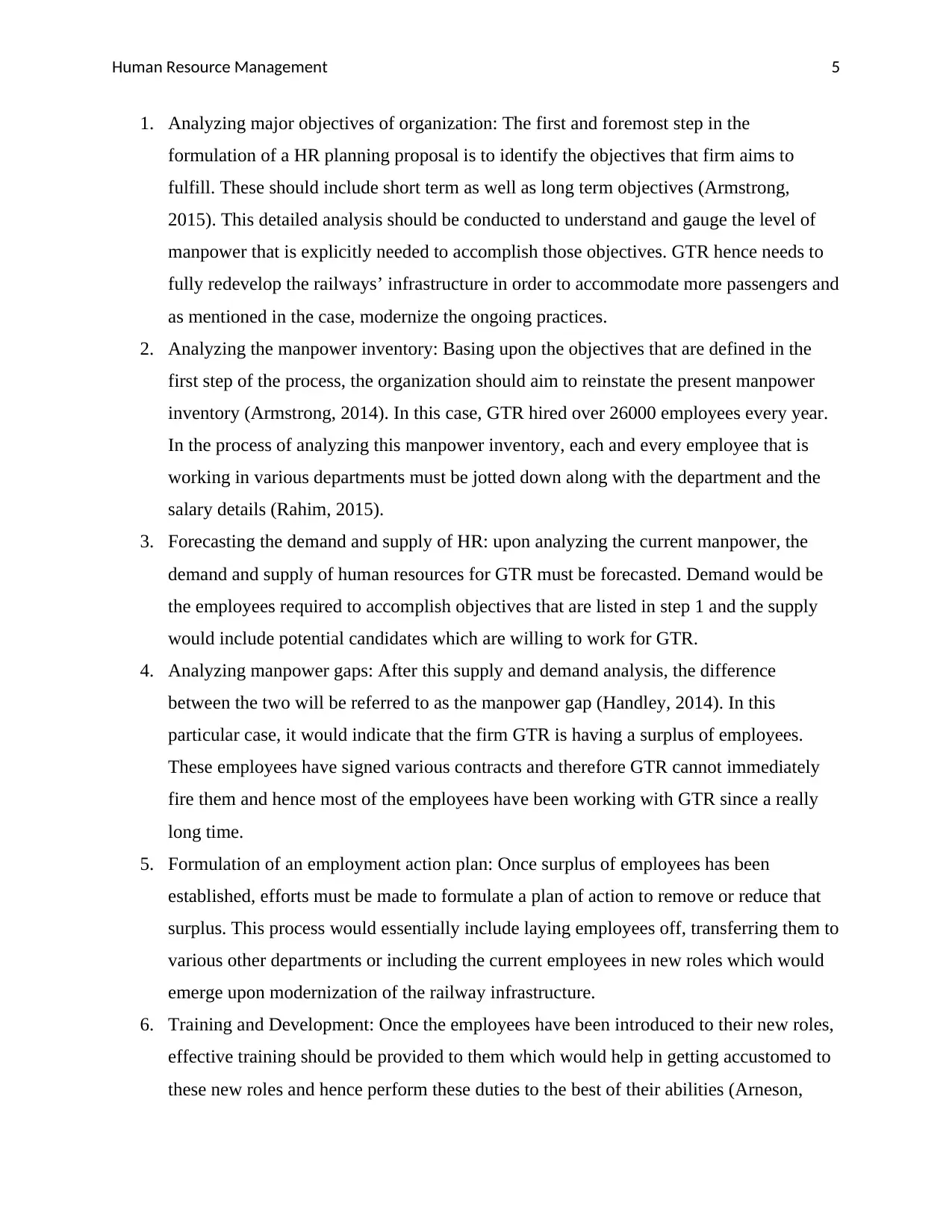
Human Resource Management 5
1. Analyzing major objectives of organization: The first and foremost step in the
formulation of a HR planning proposal is to identify the objectives that firm aims to
fulfill. These should include short term as well as long term objectives (Armstrong,
2015). This detailed analysis should be conducted to understand and gauge the level of
manpower that is explicitly needed to accomplish those objectives. GTR hence needs to
fully redevelop the railways’ infrastructure in order to accommodate more passengers and
as mentioned in the case, modernize the ongoing practices.
2. Analyzing the manpower inventory: Basing upon the objectives that are defined in the
first step of the process, the organization should aim to reinstate the present manpower
inventory (Armstrong, 2014). In this case, GTR hired over 26000 employees every year.
In the process of analyzing this manpower inventory, each and every employee that is
working in various departments must be jotted down along with the department and the
salary details (Rahim, 2015).
3. Forecasting the demand and supply of HR: upon analyzing the current manpower, the
demand and supply of human resources for GTR must be forecasted. Demand would be
the employees required to accomplish objectives that are listed in step 1 and the supply
would include potential candidates which are willing to work for GTR.
4. Analyzing manpower gaps: After this supply and demand analysis, the difference
between the two will be referred to as the manpower gap (Handley, 2014). In this
particular case, it would indicate that the firm GTR is having a surplus of employees.
These employees have signed various contracts and therefore GTR cannot immediately
fire them and hence most of the employees have been working with GTR since a really
long time.
5. Formulation of an employment action plan: Once surplus of employees has been
established, efforts must be made to formulate a plan of action to remove or reduce that
surplus. This process would essentially include laying employees off, transferring them to
various other departments or including the current employees in new roles which would
emerge upon modernization of the railway infrastructure.
6. Training and Development: Once the employees have been introduced to their new roles,
effective training should be provided to them which would help in getting accustomed to
these new roles and hence perform these duties to the best of their abilities (Arneson,
1. Analyzing major objectives of organization: The first and foremost step in the
formulation of a HR planning proposal is to identify the objectives that firm aims to
fulfill. These should include short term as well as long term objectives (Armstrong,
2015). This detailed analysis should be conducted to understand and gauge the level of
manpower that is explicitly needed to accomplish those objectives. GTR hence needs to
fully redevelop the railways’ infrastructure in order to accommodate more passengers and
as mentioned in the case, modernize the ongoing practices.
2. Analyzing the manpower inventory: Basing upon the objectives that are defined in the
first step of the process, the organization should aim to reinstate the present manpower
inventory (Armstrong, 2014). In this case, GTR hired over 26000 employees every year.
In the process of analyzing this manpower inventory, each and every employee that is
working in various departments must be jotted down along with the department and the
salary details (Rahim, 2015).
3. Forecasting the demand and supply of HR: upon analyzing the current manpower, the
demand and supply of human resources for GTR must be forecasted. Demand would be
the employees required to accomplish objectives that are listed in step 1 and the supply
would include potential candidates which are willing to work for GTR.
4. Analyzing manpower gaps: After this supply and demand analysis, the difference
between the two will be referred to as the manpower gap (Handley, 2014). In this
particular case, it would indicate that the firm GTR is having a surplus of employees.
These employees have signed various contracts and therefore GTR cannot immediately
fire them and hence most of the employees have been working with GTR since a really
long time.
5. Formulation of an employment action plan: Once surplus of employees has been
established, efforts must be made to formulate a plan of action to remove or reduce that
surplus. This process would essentially include laying employees off, transferring them to
various other departments or including the current employees in new roles which would
emerge upon modernization of the railway infrastructure.
6. Training and Development: Once the employees have been introduced to their new roles,
effective training should be provided to them which would help in getting accustomed to
these new roles and hence perform these duties to the best of their abilities (Arneson,
⊘ This is a preview!⊘
Do you want full access?
Subscribe today to unlock all pages.

Trusted by 1+ million students worldwide
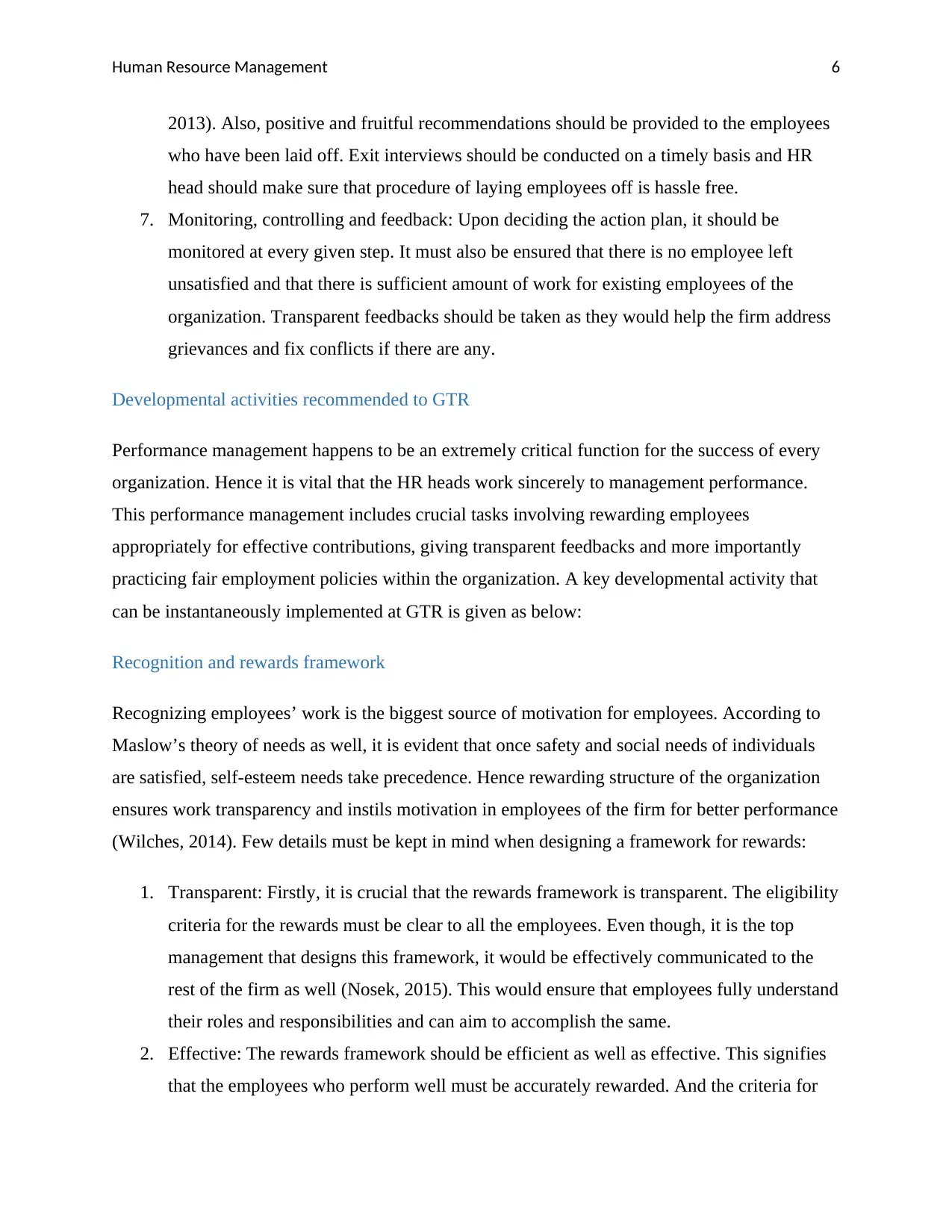
Human Resource Management 6
2013). Also, positive and fruitful recommendations should be provided to the employees
who have been laid off. Exit interviews should be conducted on a timely basis and HR
head should make sure that procedure of laying employees off is hassle free.
7. Monitoring, controlling and feedback: Upon deciding the action plan, it should be
monitored at every given step. It must also be ensured that there is no employee left
unsatisfied and that there is sufficient amount of work for existing employees of the
organization. Transparent feedbacks should be taken as they would help the firm address
grievances and fix conflicts if there are any.
Developmental activities recommended to GTR
Performance management happens to be an extremely critical function for the success of every
organization. Hence it is vital that the HR heads work sincerely to management performance.
This performance management includes crucial tasks involving rewarding employees
appropriately for effective contributions, giving transparent feedbacks and more importantly
practicing fair employment policies within the organization. A key developmental activity that
can be instantaneously implemented at GTR is given as below:
Recognition and rewards framework
Recognizing employees’ work is the biggest source of motivation for employees. According to
Maslow’s theory of needs as well, it is evident that once safety and social needs of individuals
are satisfied, self-esteem needs take precedence. Hence rewarding structure of the organization
ensures work transparency and instils motivation in employees of the firm for better performance
(Wilches, 2014). Few details must be kept in mind when designing a framework for rewards:
1. Transparent: Firstly, it is crucial that the rewards framework is transparent. The eligibility
criteria for the rewards must be clear to all the employees. Even though, it is the top
management that designs this framework, it would be effectively communicated to the
rest of the firm as well (Nosek, 2015). This would ensure that employees fully understand
their roles and responsibilities and can aim to accomplish the same.
2. Effective: The rewards framework should be efficient as well as effective. This signifies
that the employees who perform well must be accurately rewarded. And the criteria for
2013). Also, positive and fruitful recommendations should be provided to the employees
who have been laid off. Exit interviews should be conducted on a timely basis and HR
head should make sure that procedure of laying employees off is hassle free.
7. Monitoring, controlling and feedback: Upon deciding the action plan, it should be
monitored at every given step. It must also be ensured that there is no employee left
unsatisfied and that there is sufficient amount of work for existing employees of the
organization. Transparent feedbacks should be taken as they would help the firm address
grievances and fix conflicts if there are any.
Developmental activities recommended to GTR
Performance management happens to be an extremely critical function for the success of every
organization. Hence it is vital that the HR heads work sincerely to management performance.
This performance management includes crucial tasks involving rewarding employees
appropriately for effective contributions, giving transparent feedbacks and more importantly
practicing fair employment policies within the organization. A key developmental activity that
can be instantaneously implemented at GTR is given as below:
Recognition and rewards framework
Recognizing employees’ work is the biggest source of motivation for employees. According to
Maslow’s theory of needs as well, it is evident that once safety and social needs of individuals
are satisfied, self-esteem needs take precedence. Hence rewarding structure of the organization
ensures work transparency and instils motivation in employees of the firm for better performance
(Wilches, 2014). Few details must be kept in mind when designing a framework for rewards:
1. Transparent: Firstly, it is crucial that the rewards framework is transparent. The eligibility
criteria for the rewards must be clear to all the employees. Even though, it is the top
management that designs this framework, it would be effectively communicated to the
rest of the firm as well (Nosek, 2015). This would ensure that employees fully understand
their roles and responsibilities and can aim to accomplish the same.
2. Effective: The rewards framework should be efficient as well as effective. This signifies
that the employees who perform well must be accurately rewarded. And the criteria for
Paraphrase This Document
Need a fresh take? Get an instant paraphrase of this document with our AI Paraphraser

Human Resource Management 7
every reward should be explicitly defined with no ambiguity. GTR must ensure that the
entire purpose of this reward structure is to make sure that better performing employees
continue to feel valued while the employees who are non performing feel motivated.
3. Unbiased: The rewarding structure must be entirely free of bias or any personal
connections of employers with the employees. This ensures a level of transparency in the
entire process of assigning rewards. There must be checks at different levels (Team level,
department level, city level and organization level) to ensure that employees are not being
favored in an unfair manner. The performance of the rewarded employees could be made
public for others to see so that there is no kind of discrepancy in the rewarding structure.
4. Timely: Timing plays a very important role while offering rewards to employees. If
rewards are given too frequently then they may not be valued and rewards given too late
will make employees lose motivation for working towards the goals. Sometimes, a
surprise recognition in any formal or informal manner could act like a major source of
motivation for the employees.
5. Feedback: The employees that do not get rewards very often feel demotivated and
disheartened and therefore it is the responsibility of their respective managers to motivate
them by providing them a valuable feedback that would help the firm to cope and deliver
a better performance in the future.
Influence of employment legislation on HR practices
The equality act came into effect in October of 2010 with the aim to provide an easier, simpler,
consistent and more effective legal framework in order to prevent any kind of discrimination in
the workplace. This act aimed to take a very strong stance against direct and indirect forms of
discrimination that are faced by employees upon the very basis of their sexual orientation, caste,
religion, age, disability or race. This particular act has had a large influence and impacted the HR
practices throughout the UK. The key areas that are most influenced by this legislation are as
below:
1. Pay related: The equal pay act of 1970 lays emphasis upon the importance of equality of
pay within organization and across the industry. This fair pay policy is aimed at ensuring
that all employees of the same organization are treated fairly and that no employee is
every reward should be explicitly defined with no ambiguity. GTR must ensure that the
entire purpose of this reward structure is to make sure that better performing employees
continue to feel valued while the employees who are non performing feel motivated.
3. Unbiased: The rewarding structure must be entirely free of bias or any personal
connections of employers with the employees. This ensures a level of transparency in the
entire process of assigning rewards. There must be checks at different levels (Team level,
department level, city level and organization level) to ensure that employees are not being
favored in an unfair manner. The performance of the rewarded employees could be made
public for others to see so that there is no kind of discrepancy in the rewarding structure.
4. Timely: Timing plays a very important role while offering rewards to employees. If
rewards are given too frequently then they may not be valued and rewards given too late
will make employees lose motivation for working towards the goals. Sometimes, a
surprise recognition in any formal or informal manner could act like a major source of
motivation for the employees.
5. Feedback: The employees that do not get rewards very often feel demotivated and
disheartened and therefore it is the responsibility of their respective managers to motivate
them by providing them a valuable feedback that would help the firm to cope and deliver
a better performance in the future.
Influence of employment legislation on HR practices
The equality act came into effect in October of 2010 with the aim to provide an easier, simpler,
consistent and more effective legal framework in order to prevent any kind of discrimination in
the workplace. This act aimed to take a very strong stance against direct and indirect forms of
discrimination that are faced by employees upon the very basis of their sexual orientation, caste,
religion, age, disability or race. This particular act has had a large influence and impacted the HR
practices throughout the UK. The key areas that are most influenced by this legislation are as
below:
1. Pay related: The equal pay act of 1970 lays emphasis upon the importance of equality of
pay within organization and across the industry. This fair pay policy is aimed at ensuring
that all employees of the same organization are treated fairly and that no employee is
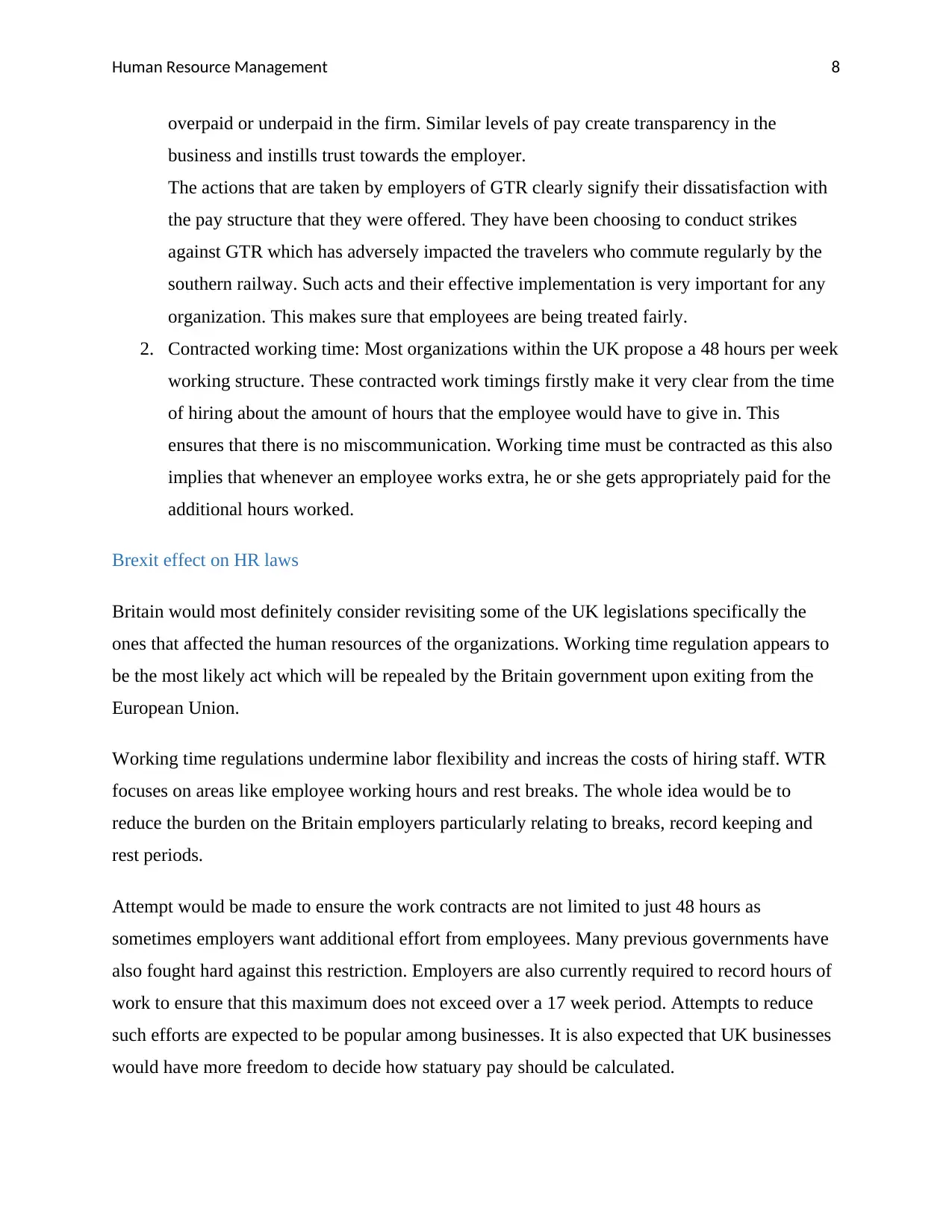
Human Resource Management 8
overpaid or underpaid in the firm. Similar levels of pay create transparency in the
business and instills trust towards the employer.
The actions that are taken by employers of GTR clearly signify their dissatisfaction with
the pay structure that they were offered. They have been choosing to conduct strikes
against GTR which has adversely impacted the travelers who commute regularly by the
southern railway. Such acts and their effective implementation is very important for any
organization. This makes sure that employees are being treated fairly.
2. Contracted working time: Most organizations within the UK propose a 48 hours per week
working structure. These contracted work timings firstly make it very clear from the time
of hiring about the amount of hours that the employee would have to give in. This
ensures that there is no miscommunication. Working time must be contracted as this also
implies that whenever an employee works extra, he or she gets appropriately paid for the
additional hours worked.
Brexit effect on HR laws
Britain would most definitely consider revisiting some of the UK legislations specifically the
ones that affected the human resources of the organizations. Working time regulation appears to
be the most likely act which will be repealed by the Britain government upon exiting from the
European Union.
Working time regulations undermine labor flexibility and increas the costs of hiring staff. WTR
focuses on areas like employee working hours and rest breaks. The whole idea would be to
reduce the burden on the Britain employers particularly relating to breaks, record keeping and
rest periods.
Attempt would be made to ensure the work contracts are not limited to just 48 hours as
sometimes employers want additional effort from employees. Many previous governments have
also fought hard against this restriction. Employers are also currently required to record hours of
work to ensure that this maximum does not exceed over a 17 week period. Attempts to reduce
such efforts are expected to be popular among businesses. It is also expected that UK businesses
would have more freedom to decide how statuary pay should be calculated.
overpaid or underpaid in the firm. Similar levels of pay create transparency in the
business and instills trust towards the employer.
The actions that are taken by employers of GTR clearly signify their dissatisfaction with
the pay structure that they were offered. They have been choosing to conduct strikes
against GTR which has adversely impacted the travelers who commute regularly by the
southern railway. Such acts and their effective implementation is very important for any
organization. This makes sure that employees are being treated fairly.
2. Contracted working time: Most organizations within the UK propose a 48 hours per week
working structure. These contracted work timings firstly make it very clear from the time
of hiring about the amount of hours that the employee would have to give in. This
ensures that there is no miscommunication. Working time must be contracted as this also
implies that whenever an employee works extra, he or she gets appropriately paid for the
additional hours worked.
Brexit effect on HR laws
Britain would most definitely consider revisiting some of the UK legislations specifically the
ones that affected the human resources of the organizations. Working time regulation appears to
be the most likely act which will be repealed by the Britain government upon exiting from the
European Union.
Working time regulations undermine labor flexibility and increas the costs of hiring staff. WTR
focuses on areas like employee working hours and rest breaks. The whole idea would be to
reduce the burden on the Britain employers particularly relating to breaks, record keeping and
rest periods.
Attempt would be made to ensure the work contracts are not limited to just 48 hours as
sometimes employers want additional effort from employees. Many previous governments have
also fought hard against this restriction. Employers are also currently required to record hours of
work to ensure that this maximum does not exceed over a 17 week period. Attempts to reduce
such efforts are expected to be popular among businesses. It is also expected that UK businesses
would have more freedom to decide how statuary pay should be calculated.
⊘ This is a preview!⊘
Do you want full access?
Subscribe today to unlock all pages.

Trusted by 1+ million students worldwide
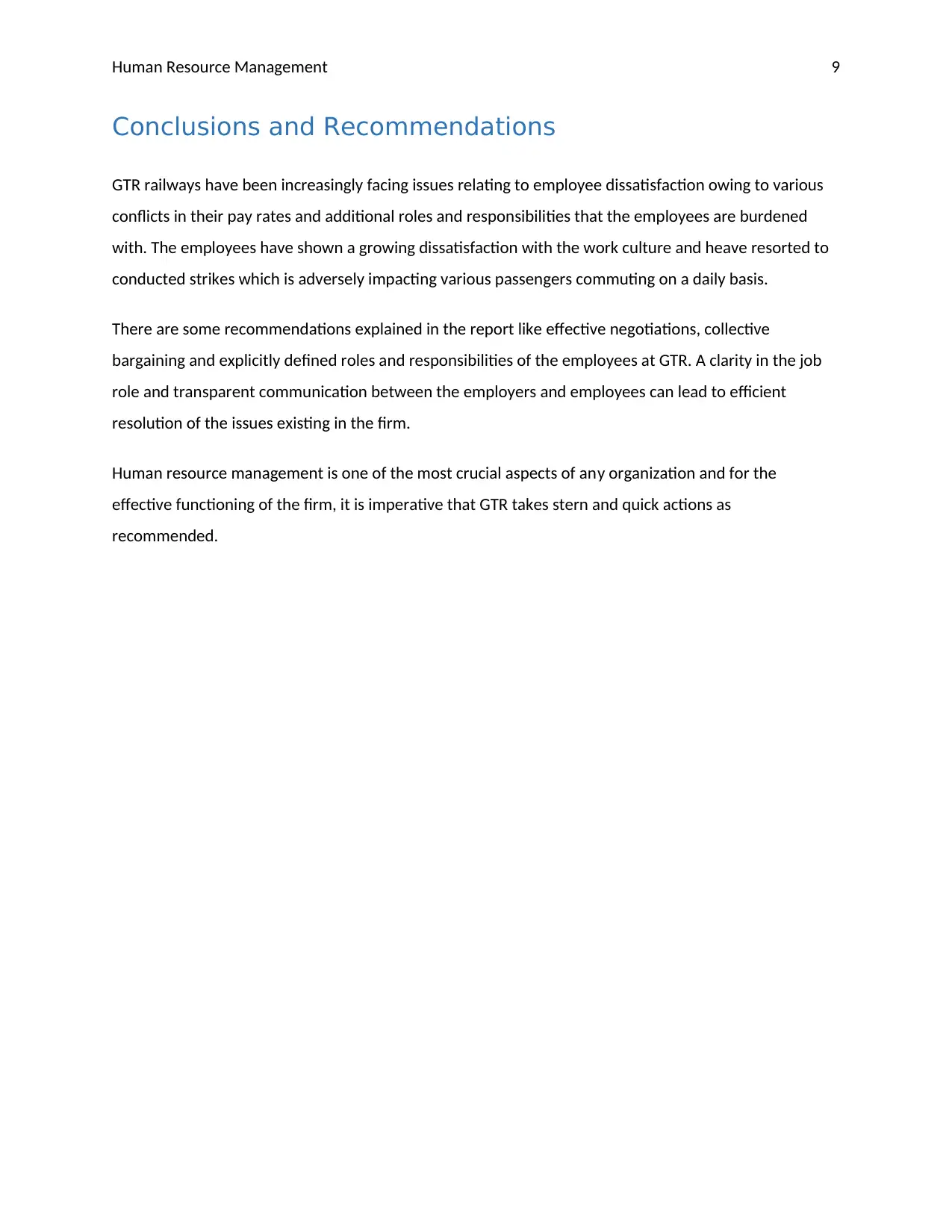
Human Resource Management 9
Conclusions and Recommendations
GTR railways have been increasingly facing issues relating to employee dissatisfaction owing to various
conflicts in their pay rates and additional roles and responsibilities that the employees are burdened
with. The employees have shown a growing dissatisfaction with the work culture and heave resorted to
conducted strikes which is adversely impacting various passengers commuting on a daily basis.
There are some recommendations explained in the report like effective negotiations, collective
bargaining and explicitly defined roles and responsibilities of the employees at GTR. A clarity in the job
role and transparent communication between the employers and employees can lead to efficient
resolution of the issues existing in the firm.
Human resource management is one of the most crucial aspects of any organization and for the
effective functioning of the firm, it is imperative that GTR takes stern and quick actions as
recommended.
Conclusions and Recommendations
GTR railways have been increasingly facing issues relating to employee dissatisfaction owing to various
conflicts in their pay rates and additional roles and responsibilities that the employees are burdened
with. The employees have shown a growing dissatisfaction with the work culture and heave resorted to
conducted strikes which is adversely impacting various passengers commuting on a daily basis.
There are some recommendations explained in the report like effective negotiations, collective
bargaining and explicitly defined roles and responsibilities of the employees at GTR. A clarity in the job
role and transparent communication between the employers and employees can lead to efficient
resolution of the issues existing in the firm.
Human resource management is one of the most crucial aspects of any organization and for the
effective functioning of the firm, it is imperative that GTR takes stern and quick actions as
recommended.
Paraphrase This Document
Need a fresh take? Get an instant paraphrase of this document with our AI Paraphraser

Human Resource Management 10
References:
Anker, R. and Anker, N., 2017. In kind benefits as partial payment of wages: A review of laws
around the world. Political Economy Research Institute. University of Massachusetts. Amherst.
Armstrong, G., Kotler, P., Harker, M. and Brennan, R., 2015. Marketing: an introduction.
Pearson Education.
Armstrong, M. and Taylor, S., 2014. Armstrong's handbook of human resource management
practice. Kogan Page Publishers.
Arneson, J., Rothwell, W. and Naughton, J., 2013. Training and development competencies
redefined to create competitive advantage. Training & Development, 67(1), pp.42-47.
Chen, Y. and Wang, Z., 2015. Initiation of Merger and Acquisition Negotiation with Two-Sided
Private Information.
Cheng, L., 2017. Organized labor and debt contracting: Firm-level evidence from collective
bargaining. Accounting Review, 92(3), pp.57-85.
Cooper, D. and Mishel, L., 2015. The Erosion of Collective Bargaining Has Widened the Gap
between Productivity and Pay. Economic Policy Institute, Washington, DC.
www.epi.org/publication/collective-bargainings-erosion-expanded-the-productivity-pay-gap/.
Pp.124-152
Handley, H.A. and Knapp, B.G., 2014. Where are the people? The human viewpoint approach
for architecting and acquisition. DEFENSE ACQUISITION UNIV FT BELVOIR VA.
Hendry, C., 2012. Human resource management. Routledge.
Huynh, M., Appell, R. and Stetkiewicz, M., 2014. Process mapping.
Jackson, M.P., Leopold, J.W., Tuck, K. and Shams, S.R., 2016. Decentralization of Collective
Bargaining: An Analysis of Recent Experience in the UK. Springer.
Korobkin, R., 2014. Negotiation: Theory and strategy. Wolters Kluwer Law & Business.
References:
Anker, R. and Anker, N., 2017. In kind benefits as partial payment of wages: A review of laws
around the world. Political Economy Research Institute. University of Massachusetts. Amherst.
Armstrong, G., Kotler, P., Harker, M. and Brennan, R., 2015. Marketing: an introduction.
Pearson Education.
Armstrong, M. and Taylor, S., 2014. Armstrong's handbook of human resource management
practice. Kogan Page Publishers.
Arneson, J., Rothwell, W. and Naughton, J., 2013. Training and development competencies
redefined to create competitive advantage. Training & Development, 67(1), pp.42-47.
Chen, Y. and Wang, Z., 2015. Initiation of Merger and Acquisition Negotiation with Two-Sided
Private Information.
Cheng, L., 2017. Organized labor and debt contracting: Firm-level evidence from collective
bargaining. Accounting Review, 92(3), pp.57-85.
Cooper, D. and Mishel, L., 2015. The Erosion of Collective Bargaining Has Widened the Gap
between Productivity and Pay. Economic Policy Institute, Washington, DC.
www.epi.org/publication/collective-bargainings-erosion-expanded-the-productivity-pay-gap/.
Pp.124-152
Handley, H.A. and Knapp, B.G., 2014. Where are the people? The human viewpoint approach
for architecting and acquisition. DEFENSE ACQUISITION UNIV FT BELVOIR VA.
Hendry, C., 2012. Human resource management. Routledge.
Huynh, M., Appell, R. and Stetkiewicz, M., 2014. Process mapping.
Jackson, M.P., Leopold, J.W., Tuck, K. and Shams, S.R., 2016. Decentralization of Collective
Bargaining: An Analysis of Recent Experience in the UK. Springer.
Korobkin, R., 2014. Negotiation: Theory and strategy. Wolters Kluwer Law & Business.
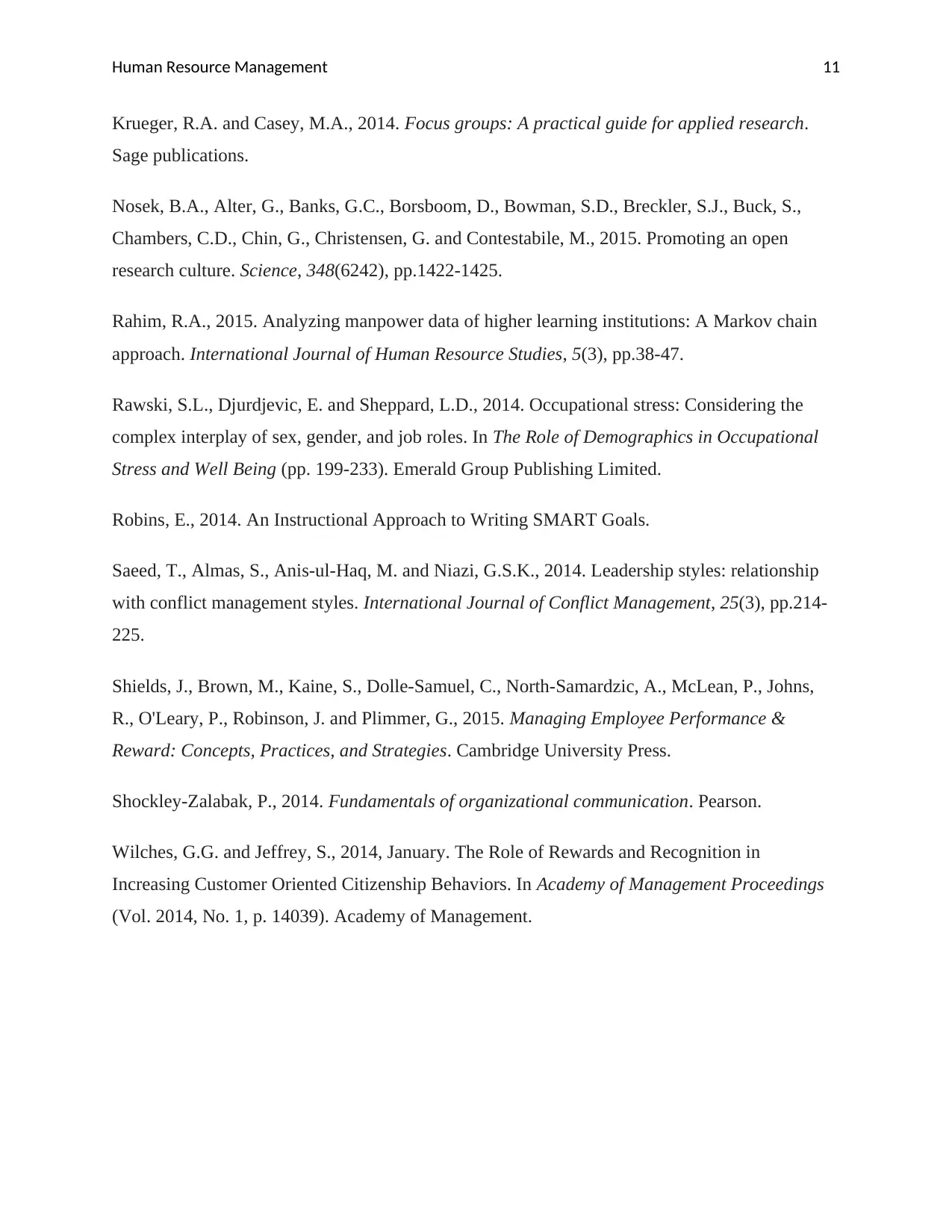
Human Resource Management 11
Krueger, R.A. and Casey, M.A., 2014. Focus groups: A practical guide for applied research.
Sage publications.
Nosek, B.A., Alter, G., Banks, G.C., Borsboom, D., Bowman, S.D., Breckler, S.J., Buck, S.,
Chambers, C.D., Chin, G., Christensen, G. and Contestabile, M., 2015. Promoting an open
research culture. Science, 348(6242), pp.1422-1425.
Rahim, R.A., 2015. Analyzing manpower data of higher learning institutions: A Markov chain
approach. International Journal of Human Resource Studies, 5(3), pp.38-47.
Rawski, S.L., Djurdjevic, E. and Sheppard, L.D., 2014. Occupational stress: Considering the
complex interplay of sex, gender, and job roles. In The Role of Demographics in Occupational
Stress and Well Being (pp. 199-233). Emerald Group Publishing Limited.
Robins, E., 2014. An Instructional Approach to Writing SMART Goals.
Saeed, T., Almas, S., Anis-ul-Haq, M. and Niazi, G.S.K., 2014. Leadership styles: relationship
with conflict management styles. International Journal of Conflict Management, 25(3), pp.214-
225.
Shields, J., Brown, M., Kaine, S., Dolle-Samuel, C., North-Samardzic, A., McLean, P., Johns,
R., O'Leary, P., Robinson, J. and Plimmer, G., 2015. Managing Employee Performance &
Reward: Concepts, Practices, and Strategies. Cambridge University Press.
Shockley-Zalabak, P., 2014. Fundamentals of organizational communication. Pearson.
Wilches, G.G. and Jeffrey, S., 2014, January. The Role of Rewards and Recognition in
Increasing Customer Oriented Citizenship Behaviors. In Academy of Management Proceedings
(Vol. 2014, No. 1, p. 14039). Academy of Management.
Krueger, R.A. and Casey, M.A., 2014. Focus groups: A practical guide for applied research.
Sage publications.
Nosek, B.A., Alter, G., Banks, G.C., Borsboom, D., Bowman, S.D., Breckler, S.J., Buck, S.,
Chambers, C.D., Chin, G., Christensen, G. and Contestabile, M., 2015. Promoting an open
research culture. Science, 348(6242), pp.1422-1425.
Rahim, R.A., 2015. Analyzing manpower data of higher learning institutions: A Markov chain
approach. International Journal of Human Resource Studies, 5(3), pp.38-47.
Rawski, S.L., Djurdjevic, E. and Sheppard, L.D., 2014. Occupational stress: Considering the
complex interplay of sex, gender, and job roles. In The Role of Demographics in Occupational
Stress and Well Being (pp. 199-233). Emerald Group Publishing Limited.
Robins, E., 2014. An Instructional Approach to Writing SMART Goals.
Saeed, T., Almas, S., Anis-ul-Haq, M. and Niazi, G.S.K., 2014. Leadership styles: relationship
with conflict management styles. International Journal of Conflict Management, 25(3), pp.214-
225.
Shields, J., Brown, M., Kaine, S., Dolle-Samuel, C., North-Samardzic, A., McLean, P., Johns,
R., O'Leary, P., Robinson, J. and Plimmer, G., 2015. Managing Employee Performance &
Reward: Concepts, Practices, and Strategies. Cambridge University Press.
Shockley-Zalabak, P., 2014. Fundamentals of organizational communication. Pearson.
Wilches, G.G. and Jeffrey, S., 2014, January. The Role of Rewards and Recognition in
Increasing Customer Oriented Citizenship Behaviors. In Academy of Management Proceedings
(Vol. 2014, No. 1, p. 14039). Academy of Management.
⊘ This is a preview!⊘
Do you want full access?
Subscribe today to unlock all pages.

Trusted by 1+ million students worldwide
1 out of 12
Related Documents
Your All-in-One AI-Powered Toolkit for Academic Success.
+13062052269
info@desklib.com
Available 24*7 on WhatsApp / Email
![[object Object]](/_next/static/media/star-bottom.7253800d.svg)
Unlock your academic potential
Copyright © 2020–2025 A2Z Services. All Rights Reserved. Developed and managed by ZUCOL.





